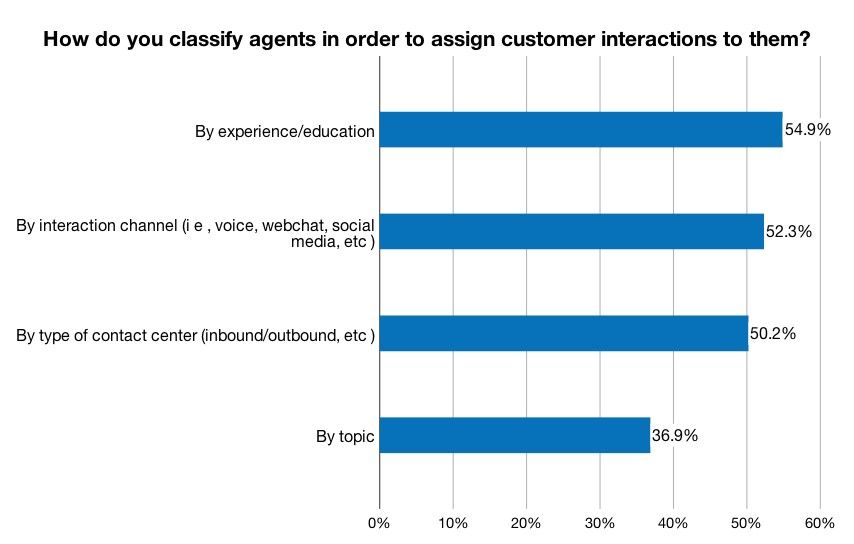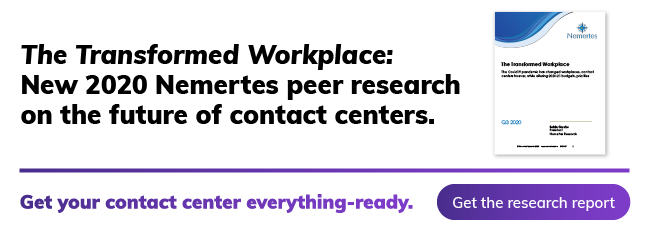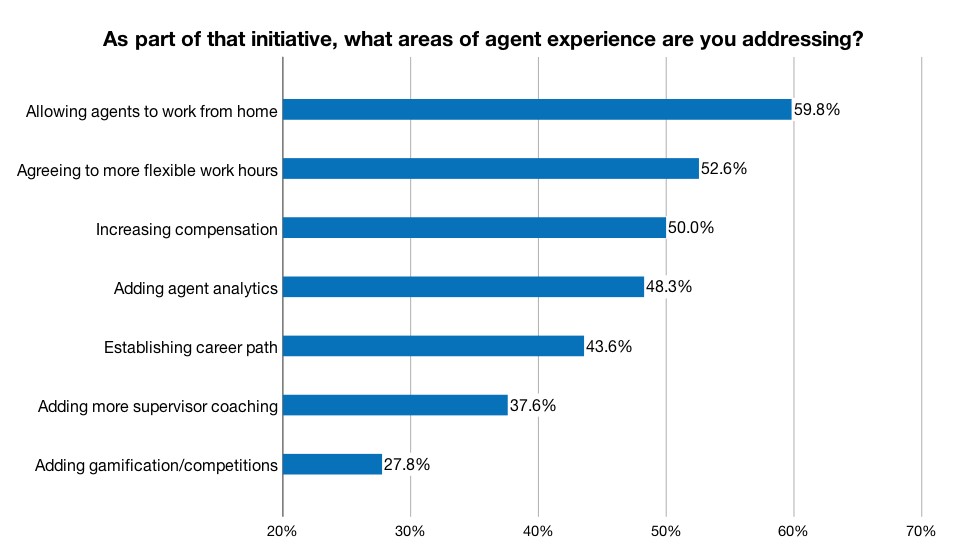Many CX leaders had their first experiences with some or all of their contact center agents working from home in 2020. Though the new work-from-home (WFH) environment was unplanned—and originally thought to be short-lived—it’s become a way of life now for more than 70% of organizations.
Even the biggest skeptics have found benefits with WFH that enable them to now rethink how they want to operate customer interactions. Most organizations (56.8%) in our Customer Engagement Transformation: 2020-21 Research Study already have decided to continue with a WFH strategy once the pandemic has passed. Only 7.6% have decided all agents will return to the contact center, and 35.6% are still evaluating their plans, according to the study, which included insights from 700 organizations.
The reimagined, work-from-anywhere contact center has several benefits, which I will detail in this blog. They include:
- Scheduling flexibility – By eliminating the rigidity of 9-to-5 scheduling, CX leaders can improve work-life balance for agents, while quickly responding to increased call volumes because agents can handle customer inquiries from anywhere.
- Geographic freedom – CX leaders are no longer tied to the city in which the contact center is located, allowing them to save money and find qualified agents.
- Channels and assignments – As customer demands continue to evolve, the interaction channels (and associated training) help CX leaders to be more flexible in assigning specific types of interactions to specific agents.
- Successful management – CX leaders can create a solid management framework by crafting a compelling employment plan, backed by analytics and KPIs to measure success.
Scheduling Flexibility Lets You Turn on a Dime
There are significant benefits in continuing to allow agents to work from home, whether all or some work from home. I think the best strategy for those transforming their CX strategies is to assign all agents work from home part time, and work in the office part time for those in the geographic area of the organization’s physical contact center(s). Or, if they are hiring from anywhere, allow those who are working away from the contact center to continue working from home, and others near the contact center to work at the office full- or part-time. This way, all or most agents are prepared for the next disaster with a home office that is regularly tested, while also having the scheduling flexibility that increases loyalty.
Indeed, one of the most profound benefits of a WFH strategy is flexibility in scheduling agent availability. There are two key outcomes to offering a better work-life balance.
- Agents are more loyal to the company, which reduces turnover rates.
- Customer service improves because of the increased availability of agents to handle rising interaction volumes.
Already, 67.7% of our research participants allow agents to work split shifts and 77.6% let agents work flexible hours to accommodate personal needs. For example, during the pandemic, some agents worked early morning shifts before their kids were awake. Then, they were off during the school day to help virtual learners with school work. After some free time, they returned to work for a night shift. It simply provided the work-life balance they needed to care for their family and continue to make financial ends meet. Others simply needed flexibility in their shifts, perhaps starting an hour or two later one day a week.
And it’s important to note: The scheduling flexibility will improve the health of all agents. In the past, agents who had colds or other minor illnesses would come to work because they needed to pay their bills. Now, those feeling under the weather, but still well enough to work, can work from home to keep coworkers from catching a virus, while also making sure the company isn’t short-staffed serving customers.
While these flexible scheduling options help agents, they also help customers: 81% of the research participants said their agents work flexible hours to accommodate customer needs. Some spikes in traffic, such as retail sites during the holidays, are predictable. Companies can schedule around those requirements—and offer flexibility in how the extra hours may offset normal hours. In other cases, the spikes in traffic may not be predictable. For example, a severe regional weather situation or other national emergency may affect hotel and airline contact centers. By equipping agents to work from home, or work from anywhere, they can immediately increase staff to handle the traveler interactions.
By allowing agents flexibility, CX leaders will increase their loyalty and be able to reduce turnover rates, which inched up in 2020 to 23.6%, up from 21% in 2019. In fact, 49.2% of companies have a strategic initiative to improve agent retention, and allowing agents to work from home is the top part of the retention program, followed by agreeing to more flexible work hours (see chart below).
The scheduling flexibility also will improve customer satisfaction. When customers can achieve resolution to a problem quickly—whether via voice, video, webchat, SMS, or another channel—they will rate the company higher and perhaps even post a positive note on social media. The flexibility of a reimagined contact center allows supervisors to quickly ramp up agent engagement regardless of where the agents are at that time—as long as they have a laptop, connectivity, and a phone or headset.
Geography - What’s That?
Work-from-home for many organizations translates into a true work-from-anywhere. Existing agents can work from home, from a vacation, or from a car. But the geography issue also extends where supervisors can search for new agents. Since the pandemic, 47% of research participants are hiring agents from any location because they now can work remotely. A work-from-anywhere strategy opens many doors for CX leaders, particularly those tied to hiring agents in expensive cities.
By expanding where companies can hire agents, they have a broader pool of candidates with in-demand skills. More than one-third of companies in our study (34.5%) said they are having difficulty finding agents with the experience they needed. By expanding to new geographies, they can find these skillsets from a broader candidate pool.
Or, if they don’t want to hire direct, they can leverage the use of outsourced contact centers. Already since the pandemic, 37.5% of organizations are using more outsourced agents, further expanding the options available to fill agent positions. Contact centers in the research study filled 16.1% of agent positions with outsourced partners.
The other benefit of hiring from anywhere is cost savings. The average hourly rate of an agent in San Francisco or New York will be much higher than in Omaha, Nebraska, or Birmingham, Alabama.
In addition, companies can reduce the amount of commercial office space they need. Already, 39.4% organizations are reducing office space because of WFH success.
At an average annual real-estate cost of $7,952 per agent, a 500-agent contact center that eliminates half of its space can save almost $2 million per year.
That savings can be diverted to technology that will improve the success of remote agents, which translates into customer satisfaction.
Making the Right Channels and Assignments
With an expanding agent workforce that includes new skillsets to meet customer demand, supervisors can better align skills with interactions. Today, 57.7% of customers are interacting via digital channels, with 49.5% of their transactions starting with digital channels and 38.9% of those digital transactions escalating to live agents.
The top interaction channels today are voice, email, social media, SMS, and Facebook Messenger, among several others. But, we are seeing declines in the use of email (13%), SMS (6.4%), and webchat (4.7%). The channels that increased in 2020 are mobile business chat (42.7%), voice (20.2%), video (15.8%), social media (13.2%), and in-app messaging (12%).
The possibilities are endless as to how to divide the workload. Today, 41.7% of agents handle both voice and digital channels; 26.1% handle voice only, and 20.1% handle digital only. Moving forward, this may change. For example, some remote agents may be assigned to all or specific digital channels. This may work well for those who have connectivity issues for real-time voice or video calls, or those who are new and first will handle more basic questions. If the issues require more experience or live voice interaction, they would be transferred to a more experienced agent.
Or, voice interactions may be handled only by those in the contact center (to control background noise and for customer privacy reasons) or in private home offices (i.e., the door closes). Digital transactions may be handled exclusively by those who are good at multi-tasking and managing multiple transactions at a time—key for reducing the cost per interaction.
CX leaders classify agents in a variety of ways to assign them to interactions that will result in the highest success. In addition to the interaction channel itself (52.3%), they also consider:
- Experience and education (54.9%) – more experienced agents typically handle more complex issues
- The type of contact center (50.2%) –inbound typically for customer service and outbound commonly for sales)
- The topic – as companies produce more products and services, agents may be trained specifically on a certain topic
 Looking for Success? Start With Effective Management
Looking for Success? Start With Effective Management
In the transformed, work-from-anywhere contact center, management skills, Key Performance Indicators (KPIs), and supporting technologies require complete overhauls. Managing remote teams, particularly those who are regularly communicating with the most important component of any company—its customers, is far more challenging than managing teams in person. But with the right tools and structure, management can be very successful.
Contact center supervisors require collaborative applications to effectively manage remote agents. They need video conferencing to make coaching calls more personal, along with team collaboration for workspaces to collaborate on strategies, customers, and agent performance. In fact, 67.2% say video is vital to managing remote employees, and 57.5% say team collaboration is vital.
Video and team collaboration are enabling technologies for agents to communicate with each other and their supervisors. Agent analytics tools provide the reporting that support coaching advice from the supervisors. Nearly half of organizations say these tools are vital for remote management. They provide insight on individual agent and team performance, segmented by various metrics (time of day, topic of discussion, interaction channel, post-call survey ratings, and more). The analysis includes recommendations for improvement—and the hard data and charts the supervisor and agent can review via screen sharing.
KPIs vary, based on the organization and its goals. Customer satisfaction (CSAT score) remains king, with 65.8% of companies citing it as the top KPI in use. Additional KPIs include first-call resolution (45.6%), average time in queue (44.6%), call handle time (43.4%), and call hold time (38.1%).
With more remote agents, other KPIs likely will emerge. For example, CX leaders should manage call quality and correlate with the CSAT score. This will show whether poor last-mile Internet connections are affecting CSAT.
They also should more regularly survey agents to track how well they like their work-from-anywhere situations, and whether the flexibility is making them more loyal to the company. This will give an indicator of potential turnover problems, and it will highlight problems some agents may have with isolation so supervisors can address them quickly.
As schedules continue to become even more flexible, actually setting a schedule becomes more complex. Workforce Management (WFM) tools, as part of broader Workforce Optimization (WFO tools) should be on supervisors’ wish lists. WFM tools automate scheduling, which helps make sure there are not staff shortages—particularly during predictably higher volumes of business.
Another important management consideration is making sure agents still feel they are part of a team. Using gamification to inject competitiveness—even though the contact center digital billboards will be replaced by virtual ones—facilitates team camaraderie. Also, make sure agents feel connected to the rest of the company by providing them with clear career paths. The loyalty generated by flexible schedules can transfer to other knowledge work positions in the company, in areas such as marketing, product development, sales, and even human resources.
Planning Starts Now
Given most CX leaders have seen first-hand the benefits of empowering agents to work from home (or anywhere!), now is the time to pull together a strategy for success. Make sure to factor:
- Rules for allowing flexible schedules, along with the WFM tools to support it
- Whether there will be geographical hiring limitations
- To what extend you’ll use outsourced partners to help serve customers
- How you plan to assign agents to customer interactions—by channel, topic, education, or type of contact center
- Which KPIs you will track, and which analytics tools you will use to measure success
For more information check out the Nemertes Research Report.










